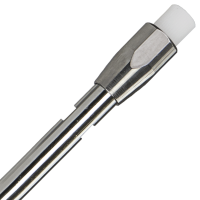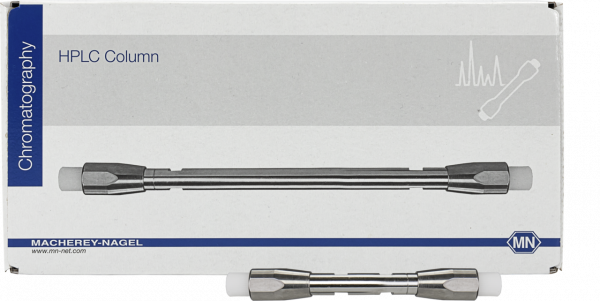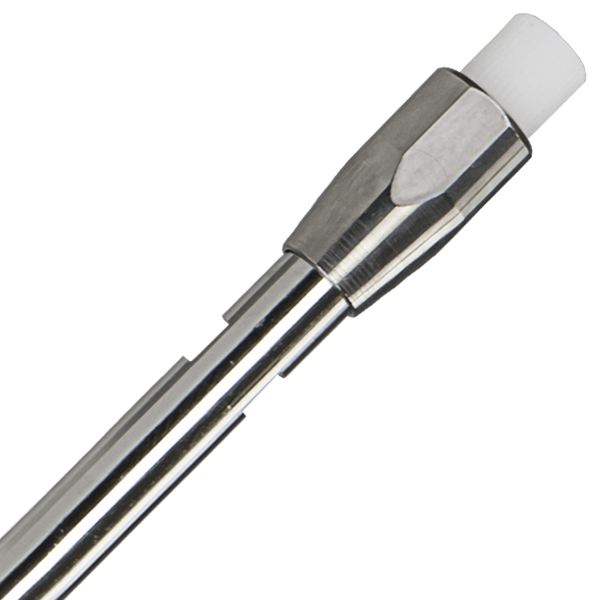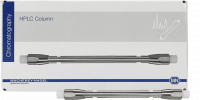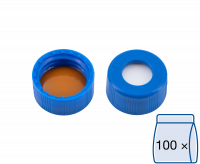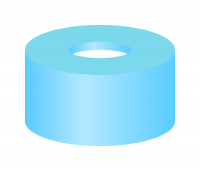EC HPLC column (analytical), NUCLEODUR PFAS, 3 µm, 50x2 mm
*taxes and shipping not included
Delivery time approx. 5 working days
Hydrophobic reversed phase with distinct polar selectivity for special PFAS analysis. Suitability for PFAS analysis is assured through qualified batch analysis. This HPLC phase is made of high purity NUCLEODUR HPLC silica gel and is extensively endcapped. Due to a low bleeding characteristics these columns are suitable for high sensitivity LC/MS analysis.
| Method | HPLC, analytical |
| Brand | NUCLEODUR |
| Base material | NUCLEODUR - high purity silica |
| Phase | NUCLEODUR PFAS |
| USP listing | Not available or proprietary |
| Surface chemistry | Proprietary |
| Mode | Reversed phase (RP) |
| Type | EC HPLC column (analytical) |
| Hardware | Stainless steel |
| Column length | 50 mm |
| Column inner diameter | 2 mm |
| Particle type | Fully porous particle (FPP) |
| Particle shape | Spherical |
| Particle size | 3 µm |
| Eluent in HPLC column | Acetonitrile – water |
| Recommended application(s) | PFAS |
| Endcapped | Yes |
| Carbon content | Not available or proprietary |
| pH stability | 1.0–9.0 |
| Pore size | 110 Å |
| Specific surface according to BET | 340 m²/g |
| Temperature stability (max) | 60 °C |
| Pressure stability (max) | 600 bar / 8700 psi |
| Column volume | 0.15 mL |
| Storage temperature | 15–25 °C / 59–77 °F |
| Scope of delivery | 1x analytical HPLC column, instruction leaflet, certificate of analysis + batch document |
| Gross weight (incl. packaging) | 186 g / 0.41 lbs |
| Packaging dimensions | 115 x 235 x 50 mm / 4.53 x 9.25 x 1.97 Inch |
| Hazardous material | No |
- Download Instructions NUCLEODUR PFAS HPLC columns (DE/EN)
- Download Application Note: PFAS analysis according to EPA 8327 (EN)
- Download Application Note - PFAS analysis according to ISO 21675:2019, DIN 38407-42 (EN)
- Download Application Note: PFAS HPLC analysis according to EPA 533 and 537.1(EN)
- Download Application Note: PFAS analysis according to EPA 533 (EN)
- Download Application Note: PFAS analysis according to EPA 537.1 (EN)
- Download Brochure NUCLEODUR and NUCLEOSHELL modern HPLC phases (EN)

What you need to know about PFAS and PFAS analysis
What are PFAS?
More than 4730 compounds(1) belong to the group of PFAS (which stands for per- and polyfluoroalkyl substances) that have been produced since the 1940s. Since these compounds do not originate from nature, the global pollution is the result of human activity. All PFAS are of anthropogenic origin. PFAS are "forever chemicals", chemicals that are very persistent in the environment and in the human body.

PFAS analysis - solutions from MACHEREY-NAGEL


Where are PFAS used?
They are commonly used because of their non-sticky and tensid-like properties for various purposes:
- Textiles, textile coating, e.g., seat covers, carpets, outdoor clothing
- Fire extinguisher foams
- Food packaging, e.g., pizza cartons, paper cups
- Paper finishing
- Fibre coating
- Cookware
- Building material, e.g., water resistant lacquer
- Further consumer products, such as: furniture, polishing and cleaning agents and creams
Regulatory directives and restrictions
Tested and validated methods for PFAS analysis
- EPA Method 533: “Determination of Per- and Polyfluoroalkyl Substances in Drinking Water by Isotope Dilution Anion Exchange Solid Phase Extraction and Liquid Chromatography/Tandem Mass Spectrometry”. U.S. Environmental Protection Agency (EPA), Office of Research and Development, National Center for Environmental Assessment, Washington, DC, 2019.
- EPA Method 537.1: "Determination of Selected Per- and Polyflourinated Alkyl Substances in Drinking Water by Solid Phase Extraction and Liquid Chromatography/Tandem Mass Spectrometry (LC/MS/MS)". U.S. Environmental Protection Agency, Washington, DC, 2018/2020
- DIN 38407-42: German standard methods for the examination of water, waste water and sludge - Jointly determinable substances (group F) Part 42: Determination of selected polyfluorinated compounds (PFC) in water - Method using high performance liquid chromatography and mass spectrometric detection (HPLC/MS-MS) after solid-liquid extraction (F 42), 2011–03.
- FDA Method C-010.02: Determination of 16 Per and Polyfluoroalkyl Substances (PFAS) in Processed Food using Liquid Chromatography-Tandem Mass Spectrometry (LC-MS/MS), 2021
Success story
Customer feedback:
"Mit CHROMABOND PFAS Kartuschen REF 730283 bearbeitet man Grundwasserproben und Bodeneluate. Außerdem werden die Böden direkt mit Methanol im ASE extrahiert und die Proben dann mit Wasser verdünnt auf die SPE-Kartusche aufgegeben. Es werden über alle Analyten gute Wiederfindungsraten erzielt.
Jedoch ist die CHROMABOND PFAS die EINZIGE SPE-Phase auf dem Markt die den Analyt (P)FOSA Perfluoroctansulfonamide mit guter Wiederfindung bindet."
Mr. G. Wolz, Fraunhofer Institute for Process Engineering and Packaging IVV
PFAS in water
This application note shows the reliable and successful determination of per- and polyfluoroalkyl substances (PFAS) from drinking water with an optimized SPE method. By using CHROMABOND PFAS it is possible to achieve high recovery rates for PFAS from drinking water with good reproducibility. By the combination of different SPE sorbents in a multi-layer column it is possible to use various interaction types like ionic, hydrophobic, hydrogen bonds and dipole-dipole for the enrichment of a broad spectrum of PFAS. In this way, a SPE method could be developed with the strength of several directives EPA 537.1, EPA 533 and DIN 38407‑42.
PFAS from textiles
This application note describes the determination of per- and polyfluoroalkyl substances (PFAS) from contaminated clothing. It demonstrates the extraction of PFAS from clothing samples using CHROMABOND PFAS column, a special SPE combination phase. The eluates are finally analyzed by HPLC-MS/MS.
PFAS in contaminated soil, sediments
This application note describes the determination of per- and polyfluoroalkyl substances (PFAS) from contaminated soils. It demonstrates the extraction of PFAS from soil samples using CHROMABOND PFAS column, a special SPE combination phase, for the methodology described in DIN 38407‑42. The eluates are finally analyzed by HPLC-MS/MS.
Further information
References
(1) Organisation for Economic Co-operation and Development (OECD): Toward a New Comprehensive Global Database of Per- and Polyfluoroalkyl Substances (PFASs): Summary Report on Updating the OECD 2007 List of Per- and Polyfluoroalkyl Substances (PFASs), Series on Risk Management, No. 39, ENV/JM/MONO(2018)7.
(2) R. C. Buck, J. Franklin, U. Berger, J. M. Conder, I. T. Cousins, P. de Voogt, A. A. Jensen, K. Kannan, S. A. Mabury and S. P. J. van Leeuwen, Perfluoroalkyl and polyfluoroalkyl substances in the environment: terminology, classification, and origins, Integrated Environ. Assess. Manag., 2011, 7(4), 513–541
(3) EFSA Journal 2020;17(17):EN-1931: Outcome of a public consultation on the draft risk assessment of perfluoroalkyl substances in food
(4) Hanna Joerss, Zhiyong Xie, Charlotte C. Wagner, Wilken-Jon von Appen, Elsie M. Sunderland, and Ralf Ebinghaus: Transport of Legacy Perfluoroalkyl Substances and the Replacement Compound HFPO-DA through the Atlantic Gateway to the Arctic Ocean—Is the Arctic a Sink or a Source? Environ. Sci. Technol. 2020, Publication Date:July 29, 2020
(5) Yan Lin, Jheng-Jie Jiang, Lisa A. Rodenburg, Minggang Cai, Zhai Wu, Hongwei Ke, Mahdi Chitsaz: Perfluoroalkyl substances in sediments from the Bering Sea to the western Arctic: Source and pathway analysis, Environment International,Volume 139,2020.
(7) Directive 2013/39/EU of the European Parliament and of the Council of 12 August 2013
(8) https://www.congress.gov/bill/116th-congress/house-bill/535/text
(9) https://www.epa.gov/newsreleases/epa-delivers-results-pfas-action-plan
(10) Safe Drinking Water Act (SDWA)
(11) PFAS analysis in water for the Global Monitoring Plan of the Stockholm Convention (2015)
(12) Report from IPEN (International Pollutants Elimination Network)
[a global network of public interest organizations improving chemical policies and raising public awareness to ensure that hazardous substances are no longer produced, used, or disposed of in ways that harm human health and the environment. IPEN is registered in Sweden as a non-profit, public interest organization.]
Image credits:
(A) bymandesigns · Birgit Reitz-Hofmann ·economica20 · rimglow · jakkapan · fotomek · manla · Sly - stock.adobe.com
(B) Kamilpetran · Yuli · bilderbox · bymandesigns · Narcis Parfenti - stock.adobe.com
PFAS are organic compounds with a carbon chain in which hydrogen is substituted by fluorine. The carbon-fluorine bond is very strong which makes them “virtually indestructable“. The molecular structure of the PFAS provides them with non-sticky and tensid-like characteristics (because of their hydrophobic, lipophilic chain + hydrophilic head).
There are polymers and non-polymers. Typical polymers are fluoropolymers, side-chain flurorinated polymers and perfluoropolyethers. Typical non-polymers are perfluoroalkyl acids (PFFFAs), perfluroalkane sulfonyl fluorides (PASF), perfluroalkyl iodides (PFAIs) and per- and polyfluroalkyl ether (PFPEs) based derivatives(2).
Perfluorooctanoic acid (PFOA) and perfluorooctanesulfonic acid (PFOS) have been the most produced and studied of these chemicals.
To cut a long story short: there are many different substance groups that need to be analyzed!
The special SPE phase – CHROMABOND PFAS
Over the years many different PFAS were developed. Now, they are found in the environment (water, food, soil, animals and humans) and their problematic health effects come into play.
The challenge is that current analytical methods are limited.
To tackle this challenge, we developed a special phase for the enrichment of a broad range of PFAS which provides good reproducibility and high recovery rates.
This is possible due to the different interactions the sorbent combination offers. These interactions are recommended by DIN 38407-42, EPA 537.1 and 533 guidelines.
Our CHROMABOND PFAS is a polymer-based combination phase which contains a weak anion exchange functionality. The combination of different SPE phases makes it possible to use various interactions (dipole-dipole, ionic, hydrophobic, H-bond).
CHROMABOND PFAS provides several advantages
- Solution for various PFAS substance classes
- > 28 PFAS can be enriched
- Sorbent retention mechanisms according to DIN 38407-42, EPA 537.1 and 533 guidelines
- High capacity
- High recovery rates
Ask us for free samples of CHROMABOND PFAS
Feel free to use the contact form to request your samples in order to test CHROMABOND PFAS.

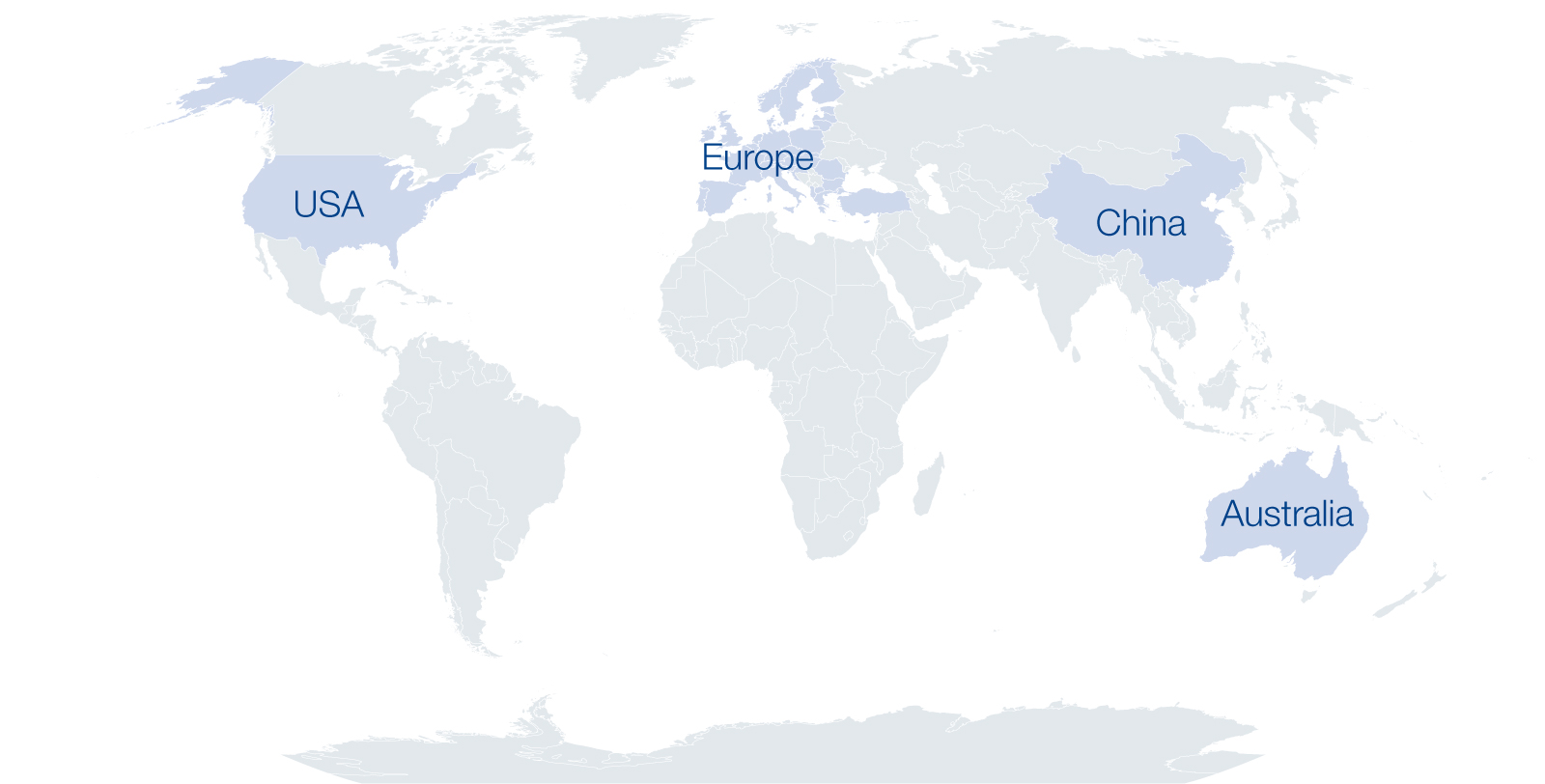
Per- and polyfluoroalkyl substances (PFAS) have been manufactured for more than 80 years, but health effects were neglected for a long time. In September 2020, the European Food Safety Authority (EFSA) published a new health risk assessment related to the presence of PFAS in food(3). This is the first EFSA expert opinion in which, in addition to PFOA and PFOS, other PFAS were also included in the exposure assessment and health risk assessment.
PFAS are emitted into the environment by different pathways. For example, exhaust air from industrial sources can contain PFAS and thus are dispersed into nearby ground and water bodies. Rain and snow, for example, can eventually carry them from the air into the soil and surface waters. Particle accumulation can even cause them to travel long distances through the air. PFAS are therefore also found far from industrial production sites and human living areas, such as in sediments from the Bering Sea to the Arctic(4/5). Through volatilization from products (evaporation from carpets or home textiles treated with soil-repellent agents) or from waterproofing sprays, indoor air can also be contaminated.
Soils can also be directly contaminated, for example by firefighting foams. With the uptake of PFAS from contaminated soils and waters in vegetation and their accumulation in fish, these substances enter the human food chain. Consequently, humans absorb PFASs from the environment through food, water or air.
These "forever chemicals" also find their way into wastewater treatment facilities from household sources. They then enter surface waters via treated wastewater or remain in sewage sludge. The sewage sludge, in turn, can be used as fertilizer in agriculture, and then over time these chemicals eventually leach into the groundwater. Once there, some of the precursor compounds are transformed into the persistent PFAS.
These forever chemicals also attracted attention through a Hollywood movie dedicated to the topic:
Dark Waters is a 2019 American legal thriller directed by Todd Haynes. The movie is based on the 2016 New York Times Magazine article "The Lawyer Who Became DuPont's Worst Nightmare" by Nathaniel Rich.
An excerpt on the regulations and monitoring of PFAS
Within the European Union (EU), Germany, Sweden and other EU member states have already started to regulate the PFAS problem several years ago. For example the Stockholm Convention has listed in 2009 the perfluorooctanesulfonic acid (PFOS), its salts and PFOSF as persistent organic pollutants (POPs)(6) and the Water Framework Directive lists PFOS as a priority hazardous substance(7).
In the United States, continuous regulatory activities are being implemented by the U.S. EPA and other initiatives. These include:
- PFAS Action Act(8)
- US EPA PFAS Plan(9)
- US EPA Commitment to PFAS Drinking Water Standards with SDWA(10).
Many institutions worldwide are working on global monitoring for PFAS. For example, a guideline on this topic was developed in 2015(11) with active participation from China, Switzerland, Canada, Japan, Fiji, Kenya, Uruguay and other countries.
However, there are still nations that are not participating in these efforts or have not implemented PFAS regulation. For example no PFAS substances are regulated in India(12).

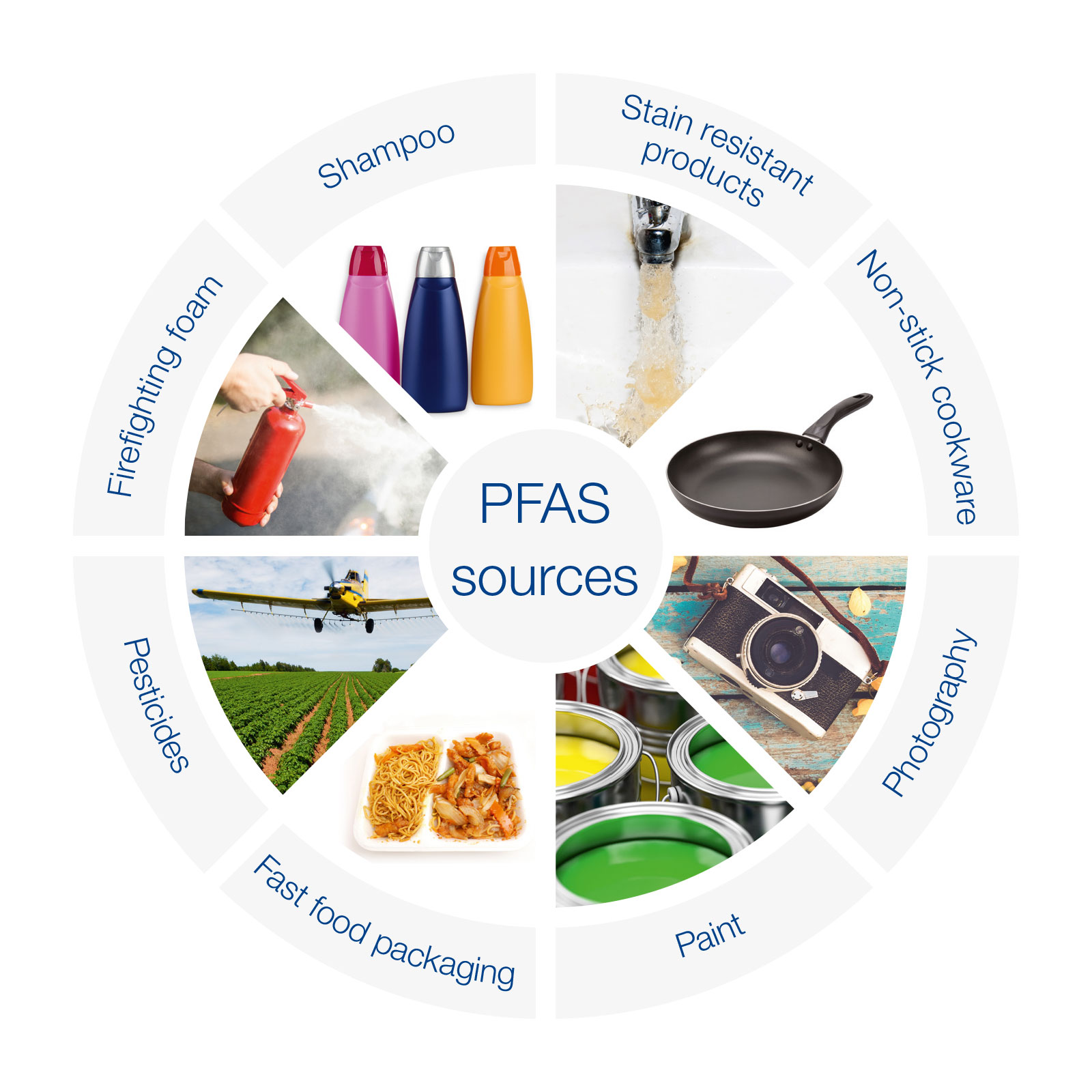
How do PFAS find their way into the environment and the human body?
As toxicological information and additional PFAS compounds become identified in the future, further directives, restrictions, and regulations will be issued over time.
This pollution will therefore affect us all for generations. Chromatographic analysis will help us quantify the impact and make monitoring possible.
SPE – solid phase extraction columns and dSPE QuEChERS mixes
HPLC - analytical columns
Vials and caps – fluorine-free
CHROMABOND PFAS
size: 6 mL/300 mg
NUCLEOSHELL RP 18plus
dimension: 50 mm length, 2 mm ID
NUCLEOSHELL RP 18plus
dimension: 100 mm length, 2 mm ID
CHROMABOND HR-XAW
size: 6 mL/500 mg
Screw neck vial, N 9, PP, transparent
11.6x32.0 mm, 0.7 mL, round bottom insert
Screw neck vial, N 9, PP, amber
11.6x32.0 mm, 0.3 mL, inner cone
Screw closure, N 9, PP, blue
Septa material: Silicone/Polyimide
Screw neck vial, N 9, PP, transparent
11.6x32.0 mm, 0.3 mL, inner cone
Screw neck vial, N 9, PP, transparent
11.6x32.0 mm, 1.5 mL, flat bottom
Snap ring closure, N 11, PE, light blue
Septa material: Silicone/Polyimide
Not all PFAS have been banned yet. This is due to, among other things, the large number of substances that belong to PFAS. A complicating factor is that their identities and uses are only partially known. The regulation places high demands on the authorities. A ban is a complex and time-consuming matter because, among other things, a suitable substitute (substitutability) is not yet possible for all applications in some cases. This concerns, for example:
- Still an indispensable component of extinguishing foams for large fires
- In special technical protective clothing
- In some medical devices
Therefore, the authorities initially regulated only those PFAS that were detected in the highest concentrations in the environment and whose effects on the environment or human health could be justified.
The regulated substances were partially replaced by other PFAS that were not yet regulated. Less or no information was available on their hazardous properties, so their need for regulation was initially unclear. However, in recent years there has been increasing evidence that the entire group of PFAS is problematic from an environmental perspective. As a result, regulators have begun to consider a comprehensive ban on all PFAS.
The major challenge is to identify those uses that require an exemption because, despite their problematic properties, their use is considered indispensable to society as a whole.
General structure of per- and polyfluoroalkyl substances (PFAS)
Considering that accumulation over time is important, a tolerable weekly intake (TWI) of 4.4 ng/kg body weight per week was established for PFASs that accumulate in the body.
CHROMABOND HR-XAW
size: 3 mL/60 mg
PFAS analysis performed on MACHEREY-NAGEL products according to official methods like EPA and DIN
EPA 1633:
Analysis of Per- and Polyfluoroalkyl Substances in Aqueous Samples by SPE and LC-MS/MS according to EPA Draft Method 1633: Application Note 11/2022
EPA 533:
Analysis of Per- and Polyfluoroalkyl Substances in Aqueous Samples with CHROMABOND® WAX according to EPA Method 533: Application Note 12/2022
The enrichment of PFAS using the SPE column CHROMABOND HR-XAW and subsequent chromatographic separation on a NUCLEODUR PFAS analytical HPLC column: PFAS analysis according to EPA 533
EPA 537.1: The enrichment of PFAS using the SPE column CHROMABOND HR-X and subsequent chromatographic separation on a NUCLEODUR PFAS analytical HPLC column: PFAS analysis according to EPA 537.1
Further Application Notes related to PFAS analysis:
Download: Application Note (PDF) - PFAS analysis according to FDA method C-010.02
Download: Application Note (PDF) - PFAS analysis according to EPA 533 and 537.1
Download: Application Note (PDF) - PFAS analysis according to ISO 21675:2019 and to DIN 38407‑42
The special HPLC columns: NUCLEODUR PFAS and NUCLEODUR PFAS Delay
NUCLEODUR PFAS, 3 µm HPLC columns provide a solution for analyzing PFAS substances.
These columns show a high batch-to-batch reproducibility, are specially batch tested for PFAS analyses and are very well suited for LC-MS due to a low bleeding characteristics.
The NUCLEODUR PFAS Delay column provide high retention for PFAS compounds and are used to retain PFAS contaminants from the HPLC system, which could otherwise falsify the sample to be analyzed. For this purpose the NUCLEODUR PFAS Delay column is connected in flow direction between the mixing vessel and the sample injector.
NUCLEODUR PFAS, 3 µm
dimension: 100 mm length, 2 mm ID
NUCLEODUR PFAS, 3 µm
dimension: 50 mm length, 2 mm ID
NUCLEODUR PFAS Delay, 5 µm
dimension: 50 mm length, 2 mm ID

CHROMABOND HR-X
size: 6 mL/500 mg
CHROMABOND HR-X, 45 µm
size: 3 mL/200 mg
PFAS in food
To protect human health, the exposure of the levels of PFAS along the food chain must be investigated more intensively. Therefore, there is need for more sensitive analytical methods for PFAS in food of animal and plant-based origin. This application note presents the analysis of PFAS from food according to FDA Method C-010.02. It shows high recoveries using a modified QuEChERS extraction technique from food samples. The extracts are finally analyzed by HPLC-MS/MS on a NUCLEODUR PFAS column.
CHROMABOND QuEChERS Mix L
Centrifuge tubes, 15 mL, 1.35 g
Per- and polyfluoroalkyl substances - a topic that affects us all. Watch the video to get an overview of how PFAS are distributed in the environment, what their chemical properties are and how to analyze PFAS chemicals using chromatography.
You are familiar with the topic of PFAS. Which products does MACHEREY-NAGEL offer for PFAS analysis?
CHROMABOND WAX
size: 6 mL/150 mg
CHROMABOND WAX
size: 6 mL/500 mg
CHROMABOND WAX
size: 6 mL/60 mg
CHROMABOND WAX
size: 6 mL/200 mg
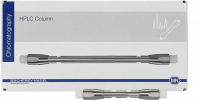 EC HPLC column (analytical), NUCLEODUR PFAS Delay, 5 µm, 50x2 mm
EC HPLC column (analytical), NUCLEODUR PFAS Delay, 5 µm, 50x2 mm 
